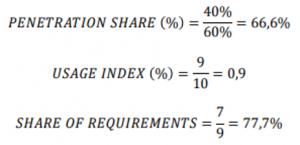THE COMPONENTS OF THE MARKET SHARE
Market share is a fundamental marketing concept. The idea is simple. The market share of a brand is the proportion of the sales of a product category that corresponds to that brand. We can calculate it by simply dividing the sales of the brand by the sales of the entire category.

Market share depends on three factors: penetration share, usage index and share of requirements.
![]()
Understanding these 3 components of market share is going to take some effort, but it is going to be worth it, as it will help us define growth strategies for the brand.
1. Penetration share is the proportion of consumers in a category who use (consume or buy) the brand at least once in a given period of time. It is calculated as follows:
![]()
It can also be calculated in this way:
![]()
2. The usage index compares the intensity of usage (consumption or purchase) by consumers of our brand with the usage by all consumers in the category. It is calculated as shown below:
![]()
3. Customers of one brand may also consume other brands in the category. In fact, absolute brand loyalty is infrequent. The consumption that the customers of a brand make on that brand in relation to what they make on the whole category is called Share of Requirements. The calculation is quite straightforward:
![]()
By multiplying these three indicators we obtain the market share:
![]()
At first glance, these three concepts and this way of calculating the market share may seem to be a little too far-fetched and unnecessarily convoluted, but we will see that this way of analyzing the market share in function of these 3 components is of great help to define different growth strategies.
 An example will help us to understand these concepts:
An example will help us to understand these concepts:

Suppose a category with a penetration of 60%. Two-thirds of the consumers in this category are consumers of brand A, thus achieving a penetration of 40%. One-third of consumers in the category (20% of the population) do not consume brand A.
Consumers in this category consume (or purchase) an average of 10 items in a given period of time. Consumers of brand A are somewhat less intensive, as they consume 9 times, of which 7 are of brand A and 2 of other brands. Those who never consume brand A are heavier consumers (12 consumptions).
Let’s calculate our 3 components:

This will therefore be the market share:
![]()
It is true that we can calculate the market share more easily by simply dividing the sales of brand A (40% x 7) by the total sales of the category (60% x 10).
![]()
However, taking into account the 3 components of the more complex equation will help us define different growth strategies for the brand.

GROWTH STRATEGIES
Penetration
Strategy Penetration strategies rely on new customers. The most obvious option would be to attract new customers in the category that are not consumers of our brand. To do this we have to make sure that potential consumers know our brand (awareness), that they will find it (distribution) and that they will have good reasons to choose it (brand value).
We can also try to persuade consumers who do not consume the category to do so, ideally with our brand. A brand may want to develop the category even knowing that part of the new consumption will go to competitor brands. When the rum market developed among young Spanish drinkers some years ago, the rum brands that worked to drive it knew that not all new consumers who switched from whisky to rum would become consumers of their brand.
Usage Strategy
The usage strategy would be to get consumers of our brand to increase their consumption of category products. If a brand can get its customers to buy more in the category than its competitors, its market share will increase.
For most categories, it is not easy to get customers to buy more. But there are known success stories. A toilet bowl cleaner wanted to increase the use of its product to increase its market share. Convincing consumers to clean their toilets more frequently didn’t seem like the right way to go. Instead, the company increased the size of the opening in the nozzle used to spray the cleaner on the toilet. The result was that a larger amount of cleaner went down the toilet, and therefore the bottles ran out earlier, requiring more frequent purchases of the product.
As a usage strategy, many companies are looking for new consumption occasions to which to extend the use of their products. For example, that cereals are not only eaten at breakfast.
Share of Requirements
Strategy One share of requirements strategy is to have your brand’s customers allocate a larger percentage of their category consumption to the brand. Consumers are rarely 100% loyal to a brand but tend to have a repertoire of brands that they consume or buy more or less frequently. It seems easier and more profitable to increase business from existing customers than to recruit new ones.
In almost all categories and for almost all brands, consumers devote a large part of their consumption to brands that are not their preferred brands. Share of Requirements’ strategies are aimed at increasing the probability of choosing our brand.
Recuerda que, si lo deseas, puedes descargar el articulo desde aquí.
